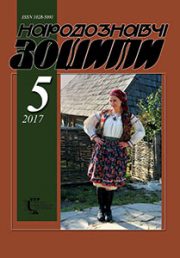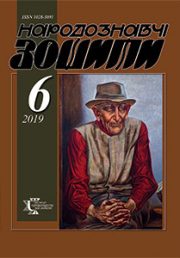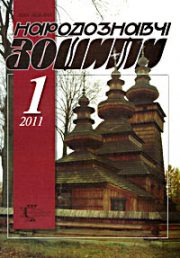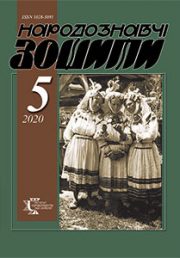The Ethnology Notebooks. 2019, 2 (146), 437—471
UDK 398.4 (477.82/.84)
DOI https://doi.org/10.15407/nz2019.02.437
DEMONOLOGY OF BEREZNE DISTRICT
HALAICHUK Volodymyr
ORCID ID: https://orcid.org/0000-0001-7780-5876
Candidate of Philology, Docent
The Ivan Franko National University of Lviv
Department of Ethnology
1, Universytets’ka str., L’viv, 79000, Ukraine
Contacts: e-mail: halay_czuk@ukr.net
Abstract. Demonological beliefs are one of the main components of the spiritual culture of the people. Therefore, the elucidation of the local specifics of certain ethnographic regions in this context is very relevant today. In the proposed exploration, the author aims to describe the picture of demonological representations of Berezne district, which is an integral part of Western Polissya. The object of research is the traditional demonology of Berezne district, and the subject is its character filling, all-Ukrainian features and local specifics. Methodological basis of the research is the principle of historicism and the use of basic methods of ethnological science. Traditional demonology of Berezne district has not been the subject of special studies yet. This aspect is covered in scholarly literature with scanty value, hence the basis of the work is the field materials of the author.
This article is a complex analysis of traditional demonology in Berezne region. The author used field research to show data about such characters as devil, mermaids, house spirits, sprites and goblins, about disease personification and different types of witches.
Mermaids in the surveyed villages are mostly considered by people who died in the Rusal week. They were wary of them, but they were often perceived in a positive way. The same dualism is inherent in the housewife, which was perceived as a devil or soul, as the owner of the house, which even had to be ritually fed. The most extensive category of demonic characters is identified by the names «vedma» and «zhychur» — the stories about them are the same with other Polissian territories, as well as stories about those who can «help» from illnesses, storms or fires. A wide arsenal of apotheopians against the witch and other «evil spirits» was used in the Berezne region. They also assisted in such measures from the deceased, who allegedly could «come» to the living. Among such deceased there are several categories: the deceased husband «comes» to his wife, the mother «comes» to the children, «go» allegedly and timely, dead and witches. The phenomena of panic, fornication and whirlwind in Berezne region are directly connected with the «unclean» and with the places of burial of the «irresponsible» deceased. The connection with the devil reveal the stories about «the color of the ferns», which are quite popular in the settlements of the district.
In this article the author determined the main features of demonology in Berezne district which is the part of other beliefs about the immortality of the soul.
Keywords: demonology, Berezne district, Polissia, mermaids, hobgoblin, witch, devil, suicide.
Received 11.02.2019
REFERENCES
[Moshkov V.]. Village of Velyki Tseptsevychi. Ethnographic materials collected by V. A. Moshkov & L. M. Pheldman in the second tour. Ethnographic materials collected by Baron Steingel for the museum. DARO. F. 366, d. 1, c. 76. 6—9 [in Russian].
Parkhomenko, T. (2008). Calendar customs and rituals of Rivne region. Rivne: Oleg Zen [in Ukrainian].
Vasyuk, O., & Khursyak, L. (2013). Therapeutic folk prayers and «zamovlyannya» from the villages of Balashivka and Yatskovich, Berezne district of Rivne region. Mythology and Folklore, 1, 111—115 [in Ukrainian].
Kovalchuk, N. (2018). The custom is to make mermaids: local forms and distribution areas on the territory of the Polissya of Ukraine and Belarus. The Ethnology Notebooks, 6, 1394—1412 [in Ukrainian].
Nikolaeva, A. (2017). Folk medicine and veterinary medicine on the territory of Berezne district of Rivne region. Chronicle of Bereznivshchyna: scientific notes of Berezne Regional Museum of Local Lore, 3, 106—132. Rivne [In Ukrainian].
Halaіchuk, V. (2015). Traditional notions about the sea in the Right-Bank Polissya. Scientific notebooks of the Faculty of History of Lviv University, 16, 151—171. Lviv [in Ukrainian].
Halaіchuk, V. (2016). Ukrainian mythology. Kharkiv: Klub Simeynoho Dozvillya [in Ukrainian].
Vinogradova, L.N., & Levkievskaya, E.E. (Eds.) (2010). Folk demonology of Polesie: publication of texts in the records of the 80—90-ies. XX century (Vol. 1). Moscow: Languages of Slavic cultures [in Russian].
Vinogradova, L.N., & Levkievskaya, E.E. (Eds.) (2012). Folk demonology of Polesie: publication of texts in the records of the 80—90-ies. XX century (Vol. 2). Moscow: Languages of Slavic cultures [in Russian].
Vinogradova, L.N., & Levkievskaya, E.E. (Eds.) (2016). Folk demonology of Polesie: publication of texts in the records of the 80—90-ies. XX century (Vol. 3). Moscow: Languages of Slavic cultures [in Russian].
Archive DNСZKSTK. F. Berezne-2013. Op. save V. Halaychuk [in Ukrainian].







